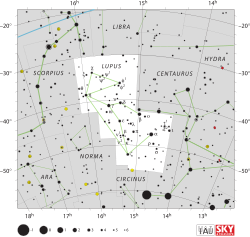Xi2 Lupi
| Observation data Epoch J2000.0 Equinox J2000.0 (ICRS) | |
|---|---|
| Constellation | Lupus |
| Right ascension | 15h 56m 54.12100s[1] |
| Declination | −33° 57′ 51.3448″[1] |
| Apparent magnitude (V) | 5.55[2] |
| Characteristics | |
| Spectral type | B9 V[3] |
| B−V color index | +0.06[2] |
| Astrometry | |
| Radial velocity (Rv) | −12.20±1.78[4] km/s |
| Proper motion (μ) | RA: +23.56[1] mas/yr Dec.: −43.29[1] mas/yr |
| Parallax (π) | 21.71 ± 4.70 mas[1] |
| Distance | approx. 150 ly (approx. 46 pc) |
| Details | |
| Mass | 2.38[5] M☉ |
| Luminosity | 10.6[6] L☉ |
| Surface gravity (log g) | 4.22±0.14[5] cgs |
| Temperature | 9,725±331[5] K |
| Rotational velocity (v sin i) | 184[5] km/s |
| Age | 381[5] Myr |
| Other designations | |
| Database references | |
| SIMBAD | data |
Xi2 Lupi (ξ2 Lup, ξ2 Lupi) is a member of a double star[8] with Xi1 Lupi in the southern constellation of Lupus. As of 2004, the pair had an angular separation of 10.254 arcseconds along a position angle of 49.21°.[9] Xi2 Lupi is visible to the naked eye with an apparent visual magnitude of 5.55.[2] Based upon an annual parallax shift of 21.71[1] mas as seen from Earth, it is located roughly 150 light-years from the Sun. It has a peculiar velocity of 14.3±1.9 km/s relative to its neighbors, and is probably (86% chance) a runaway star.[10]
This is a B-type main-sequence star with a stellar classification of B9 V.[3] It has an estimated 2.38[5] times the mass of the Sun and radiates 10.6[6] times the Sun's luminosity from its outer atmosphere at an effective temperature of 9,725 K.[5] Xi2 Lupi is about 381 million years old and is spinning relatively rapidly with a projected rotational velocity of 184 km/s.[5]
References
[edit]- ^ a b c d e f van Leeuwen, F. (2007), "Validation of the new Hipparcos reduction", Astronomy and Astrophysics, 474 (2): 653–664, arXiv:0708.1752, Bibcode:2007A&A...474..653V, doi:10.1051/0004-6361:20078357, S2CID 18759600.
- ^ a b c Høg, E.; et al. (2000), "The Tycho-2 catalogue of the 2.5 million brightest stars", Astronomy and Astrophysics, 355: L27, Bibcode:2000A&A...355L..27H, doi:10.1888/0333750888/2862.
- ^ a b Levato, H. (January 1975), "Rotational velocities and spectral types for a sample of binary systems", Astronomy and Astrophysics Supplement Series, 19: 91–99, Bibcode:1975A&AS...19...91L.
- ^ de Bruijne, J. H. J.; Eilers, A.-C. (October 2012), "Radial velocities for the HIPPARCOS-Gaia Hundred-Thousand-Proper-Motion project", Astronomy & Astrophysics, 546: 14, arXiv:1208.3048, Bibcode:2012A&A...546A..61D, doi:10.1051/0004-6361/201219219, S2CID 59451347, A61.
- ^ a b c d e f g h David, Trevor J.; Hillenbrand, Lynne A. (2015), "The Ages of Early-Type Stars: Strömgren Photometric Methods Calibrated, Validated, Tested, and Applied to Hosts and Prospective Hosts of Directly Imaged Exoplanets", The Astrophysical Journal, 804 (2): 146, arXiv:1501.03154, Bibcode:2015ApJ...804..146D, doi:10.1088/0004-637X/804/2/146, S2CID 33401607.
- ^ a b McDonald, I.; et al. (2012), "Fundamental Parameters and Infrared Excesses of Hipparcos Stars", Monthly Notices of the Royal Astronomical Society, 427 (1): 343–57, arXiv:1208.2037, Bibcode:2012MNRAS.427..343M, doi:10.1111/j.1365-2966.2012.21873.x, S2CID 118665352.
- ^ "ksi02 Lup". SIMBAD. Centre de données astronomiques de Strasbourg. Retrieved 2017-03-08.
- ^ Eggleton, P. P.; Tokovinin, A. A. (September 2008), "A catalogue of multiplicity among bright stellar systems", Monthly Notices of the Royal Astronomical Society, 389 (2): 869–879, arXiv:0806.2878, Bibcode:2008MNRAS.389..869E, doi:10.1111/j.1365-2966.2008.13596.x, S2CID 14878976.
- ^ Sinachopoulos, D.; et al. (September 2007), "CCD astrometry and components instrumental magnitude difference of 432 Hipparcos wide visual double stars", Astronomy and Astrophysics, 472 (3): 1055–1057, Bibcode:2007A&A...472.1055S, doi:10.1051/0004-6361:20066290, hdl:11427/35072.
- ^ Tetzlaff, N.; et al. (January 2011), "A catalogue of young runaway Hipparcos stars within 3 kpc from the Sun", Monthly Notices of the Royal Astronomical Society, 410 (1): 190–200, arXiv:1007.4883, Bibcode:2011MNRAS.410..190T, doi:10.1111/j.1365-2966.2010.17434.x, S2CID 118629873.
